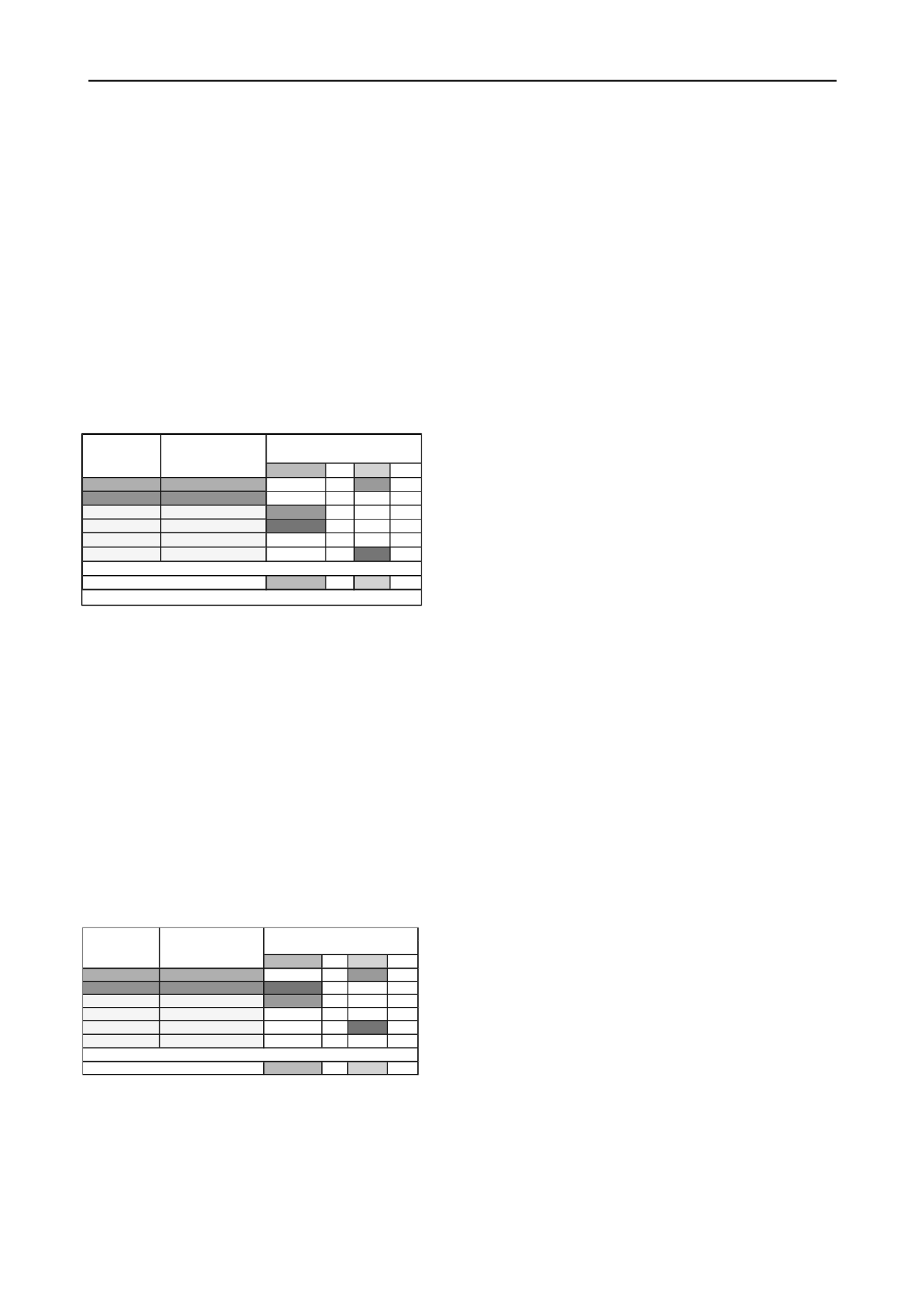
398
Proceedings of the 18
th
International Conference on Soil Mechanics and Geotechnical Engineering, Paris 2013
maximum deflection value (Do) obtained fromBenkelman beam
normalized to a standard temperature of 20°C (68°F).The
correlation equations (3) and (4) are optimal for deflections
measurements taken on flexible pavement structures of low
stiffness, it is possible to use them in deteriorated structures,
preferably without presence neither transverse nor block cracking
(especially that caused by surrounding vegetation). These
equations are recommended for deflections between 0.3 and 1.8
millimeters.
5.4
Subgrade soil modulus
Both subgrade soilresilientmodulusand effective structural
numbers obtained using AASHTO methodology prove to be
higher than those obtained using the methodology of the Hogg
Model; that is the results obtained with the Benkelman beam still
are more unfavorable just as in the analysis of the deflection
basins.
As shown in Table 5, on average in all test area, the modulus
of subgrade were 40,5MPa (5880 psi) obtained using the Benkel-
man Beam and 61,6 MPa (8931 psi) with FWD. Thesesubgrade
modulus values correspond to a fine-grained soft soil such as fat
clays and silts.
5.5
Effective structural number (SNeff)
On average, the effective structural number (SNeff) was 1,6
obtained using the methodology of the Hogg Model for
Benkelman beam measurements and 2,4 obtained using AASHTO
methodology for FWD measurements; it is demonstrated that the
structural assessment carried out with the Benkelman beam is
more critical than the one carried out with the FWD, this is
because the deflections obtained usingBenkelman beam are higher
for being taken under static load.
As shown in Table 6, these effective structural number values
are very low, representing the low pavement structural capacity
and the need for implementation of a rehabilitation project.
6
CONCLUSIONS
-Deflections under static load are higher than those generated
by dynamic load; this is due to longer duration of load application.
Therefore, the results obtained from deflection values under static
load do not represent accurately the effects made by moving loads
(moving vehicles), so the structural analysis made using static
loading equipment may generate higher costs in rehabilitation
projects.
-Most deflection basins obtained are deep and short extension,
which means presence of poor subgrade soils and low
performance of pavement layers (low structural pavement
capacity).
-Backcalculation of subgrade soil modulus is a simple non-
destructive procedure, more practical and faster than calculation
by laboratory tests; and more reliable than using correlations
based on other parameters as CBR.
-Exist a correlation (R
2
=0,82) between the deflections
obtained from Benkelman beam and FWD. The estimated
equations are recommended to use in structural analysis of low
stiffness pavement. It is possible to use them on deteriorated
structures, preferably without presence neither transverse nor
block cracking (especially that caused by surrounding vegetation).
BENK. BEAM c (%) FWD c (%)
Acceso Cl 53
[K0+000 ‐ K0+480]
42.2
59.8 77.9 14.2
Acceso Trans. 40 [K0+000 ‐ K0+280]
38.3
39.3 63.4 29.5
Anillo vial
[K0+600 ‐ K1+150]
44.4
25.0 55.1 20.0
Anillo vial
[K1+200 ‐ K1+750]
35.1
41.0 62.3 26.3
Anillo vial
[K1+800 ‐ K2+350]
42.5
56.6 59.8 17.4
Anillo vial
[K0+000 ‐ K0+550]
40.7
33.4 50.9 26.0
40.5
42.5
61.6
22.2
AVERAGE
c: Variation coefficient
SECTION Position on the road
SUBGRADE MODULUS (Mpa)
Table 5. Subgrade soil modulus obtained in each section
-It was observed that presence of damages such as block and
transverse cracking (mostly produced by the effect of tree roots)
as well as asphalt patching interventions markedly influence the
measurement, resulting deflection values lower than average. In
contrast, presence of longitudinal failures as well as drainage
structures nearby causedeflection measurements higher than
average. It is not recommended to take deflections measurements
on these areas.
-The standard deviation and coefficient of variation of data
obtained using Benkelman beam are higher than those obtained
using FWD.
7
REFERENCES
1. AASHTO, 1993. American Association of State Highway and
Transportation Officials. Guide for Design of Pavement
Structures.
2. Beena SukumaraN. 2002. Suitability of using california bearing
ratio test to predict resilient modulus. RowanUniversity.
3. Crespo del Río, Ramón. Cálculo de refuerzo de firmes según el
método AASHTO. AEPO, Ingenieros Consultores S.A.
4. Crespo del Río, Ramón. 2004. Valores de la deflexión según el
equipo de medida. AEPO, Ingenieros Consultores S.A.
5. Hoffman, Mario. 1985. Estudio de evaluación estructural de
pavimentos basados en la interpretación de curvas de deflexiones
(ensayos no destructivos). Louis Berger Internacional Inc.
6. INVIAS - Instituto Nacional de Vías. Guía metodológica para
el diseño de obras de rehabilitación de pavimentos asfalticos de
carreteras. Segundaedición.Colombia, 2008.
7.Murillo, C.; Thorel, L. & B. Caicedo. A Miniature Falling
Weight device for Non Intrusive Characterization of Soils in the
Centrifuge.Geotechnical Testing Journal. ISSN: 0149-6115 (July
2009).
Table 6. Effective structural number obtained with both techniques
BENK. BEAM c (%) FWD c (%)
Acceso Cl 53
[K0+000 ‐ K0+480]
1.6 104.2 3.0 11.9
Acceso Trans. 40 [K0+000 ‐ K0+280]
1.0
76.7 2.3 11.9
Anillo vial
[K0+600 ‐ K1+150]
2.0
44.3 2.3 11.7
Anillo vial
[K1+200 ‐ K1+750]
1.6
51.7 2.4 20.0
Anillo vial
[K1+800 ‐ K2+350]
1.6
87.9 2.2 11.3
Anillo vial
[K0+000 ‐ K0+550]
1.9
39.4 2.3 16.0
1.6
67.4
2.4
13.8
AVERAGE
SECTION Position on the road
EFFECTIVE STRUCTURAL NUMBER,
SNeff
8. Petersen Acevedo, Miguel. Relación entre módulo resiliente
determinado mediante deflectómetro de impacto y el de
laboratorio. Universidad Técnica Federico Santa María.
Valparaíso, Chile.
9. Sturm, H. and Skinner, Michael. Developmentofa pavement
management and prioritization framework for three
activemunicipal landfills. Pavement Performance Case Studies
Session of the 2012 Conference of the Transportation Association
of Canada Fredericton, New Brunswick, 2012.


